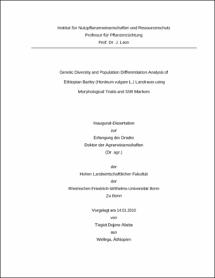Abebe, Tiegist Dejene: Genetic Diversity and Population Differentiation Analysis of Ethiopian Barley (Hordeum vulgare L.) Landraces using Morphological Traits and SSR Markers. - Bonn, 2010. - Dissertation, Rheinische Friedrich-Wilhelms-Universität Bonn.
Online-Ausgabe in bonndoc: https://nbn-resolving.org/urn:nbn:de:hbz:5N-21583
Online-Ausgabe in bonndoc: https://nbn-resolving.org/urn:nbn:de:hbz:5N-21583
@phdthesis{handle:20.500.11811/4583,
urn: https://nbn-resolving.org/urn:nbn:de:hbz:5N-21583,
author = {{Tiegist Dejene Abebe}},
title = {Genetic Diversity and Population Differentiation Analysis of Ethiopian Barley (Hordeum vulgare L.) Landraces using Morphological Traits and SSR Markers},
school = {Rheinische Friedrich-Wilhelms-Universität Bonn},
year = 2010,
month = jun,
note = {Morphological and simple sequence repeats (SSR) were used to analyze a total of 199 landraces collected from 10 administrative regions of Ethiopia and four released cultivars of barley. For the morphological data; experiments were conducted in Holetta and Bekoji agricultural research centers of Ethiopia, and the genetic analysis using molecular marker (SSR) were conducted in laboratory of INRES, University of Bonn. The objectives of this study were (1) to assess the extent of morphological and molecular variation in barley accessions in respect to regions and altitude of collection, (2) to cluster the accessions into relatively homogenous groups and to identify the major traits contributing to the overall diversity of the germplasm, (3) to estimate the population differentiation and (4) finally to identify traits which undergo selection pressure. Genetic variance estimates of regions and altitudes indicated a wide variation among accessions depending on the traits involved. Presence of high morphological variation within regions and altitudes above 2000 meter above sea level (m.a.s.l) indicated the potential of each region and higher altitudes in contributing towards barley improvement and conservation activities. Clustering of accessions was not dependant on geographic regions whereas the well adapted traits like days to heading, days to maturity, plant height and awn length, played a role in differentiating accessions collected from different regions and altitude classes into principal components. Molecular variance analysis from SSR data resulted in a high variation within region, altitude and accessions as compared to the variation among region, altitude and accessions variation. The Analysis conducted to determine the differentiation among regions and altitude classes resulted in a medium differentiation among regions accompanied by a high gene flow. While there was no significant genetic differentiation among altitude classes and high gene flow was estimated. To test if the quantitative traits were under directional or homogenizing selection molecular marker genetic differentiation was compared with qualitative trait differentiation which resulted in glucan content as traits which was not undergoing selection pressure of farmers. From this study it can be concluded that high genetic variability exists in the barley germplasm of Ethiopia. However, a high gene flow among altitudes and regions counteracts the gene frequency for local adaption of traits created by selection.},
url = {https://hdl.handle.net/20.500.11811/4583}
}
urn: https://nbn-resolving.org/urn:nbn:de:hbz:5N-21583,
author = {{Tiegist Dejene Abebe}},
title = {Genetic Diversity and Population Differentiation Analysis of Ethiopian Barley (Hordeum vulgare L.) Landraces using Morphological Traits and SSR Markers},
school = {Rheinische Friedrich-Wilhelms-Universität Bonn},
year = 2010,
month = jun,
note = {Morphological and simple sequence repeats (SSR) were used to analyze a total of 199 landraces collected from 10 administrative regions of Ethiopia and four released cultivars of barley. For the morphological data; experiments were conducted in Holetta and Bekoji agricultural research centers of Ethiopia, and the genetic analysis using molecular marker (SSR) were conducted in laboratory of INRES, University of Bonn. The objectives of this study were (1) to assess the extent of morphological and molecular variation in barley accessions in respect to regions and altitude of collection, (2) to cluster the accessions into relatively homogenous groups and to identify the major traits contributing to the overall diversity of the germplasm, (3) to estimate the population differentiation and (4) finally to identify traits which undergo selection pressure. Genetic variance estimates of regions and altitudes indicated a wide variation among accessions depending on the traits involved. Presence of high morphological variation within regions and altitudes above 2000 meter above sea level (m.a.s.l) indicated the potential of each region and higher altitudes in contributing towards barley improvement and conservation activities. Clustering of accessions was not dependant on geographic regions whereas the well adapted traits like days to heading, days to maturity, plant height and awn length, played a role in differentiating accessions collected from different regions and altitude classes into principal components. Molecular variance analysis from SSR data resulted in a high variation within region, altitude and accessions as compared to the variation among region, altitude and accessions variation. The Analysis conducted to determine the differentiation among regions and altitude classes resulted in a medium differentiation among regions accompanied by a high gene flow. While there was no significant genetic differentiation among altitude classes and high gene flow was estimated. To test if the quantitative traits were under directional or homogenizing selection molecular marker genetic differentiation was compared with qualitative trait differentiation which resulted in glucan content as traits which was not undergoing selection pressure of farmers. From this study it can be concluded that high genetic variability exists in the barley germplasm of Ethiopia. However, a high gene flow among altitudes and regions counteracts the gene frequency for local adaption of traits created by selection.},
url = {https://hdl.handle.net/20.500.11811/4583}
}






